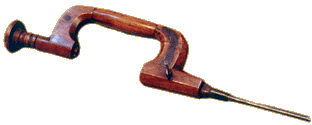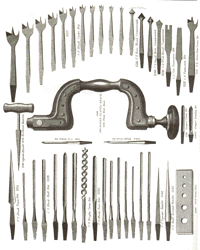 Wooden
braces were very popular and usually fancier than their iron counterparts. This one is
made of applewood. At some point in its past the from web split and was repaired with a
brass plate. These braces had bits which were permanently set into pads which were in turn
fitted into the chuck or nose of the brace. At this point in history the adjustable chuck
hadn't been introduced. Some pads were held in place temporarily with though pins, wing
screws, or spring locks. The heads were always allowed to turn to keep friction (and the
blisters) to a minimum. Get a closer view of the
object (49KB) Wooden
braces were very popular and usually fancier than their iron counterparts. This one is
made of applewood. At some point in its past the from web split and was repaired with a
brass plate. These braces had bits which were permanently set into pads which were in turn
fitted into the chuck or nose of the brace. At this point in history the adjustable chuck
hadn't been introduced. Some pads were held in place temporarily with though pins, wing
screws, or spring locks. The heads were always allowed to turn to keep friction (and the
blisters) to a minimum. Get a closer view of the
object (49KB)
"Some of my father’s men still used the old shell augers for
boring holes, but as a child, I remember being fascinated by a new spiral bit rapidly
discharging its clean-cut chips as it was turned by one of the workmen. The problem that
perplexed me was that the twist appeared to ascend as the bit bored its way deeper and
deeper into the wood - I believe that it had been newly introduced: my father’s chest
had no prepared places for that type of bit though it had special receptacles for those
known as "centre" and "shell". Also it was not until I had commenced
work that the steel ratchet brace appeared on the market; before then the wooden stocks
with spring clips for securing the bits were used by all woodworkers. They were
beautifully made, the clip workings inside a brass - mounted socket; they had also brass
inlays where the wood was cross - grained, and frequently were fitted with ebony revolving
heads...."
Excerpt from "The Village Carpenter" by Walter Rose. First
published 1937 by Cambridge University Press. Reissued 1986 by A & C Black
(Publishers) Ltd., London. Published in the US by New Amsterdam Books. New York City.

Brace Bits (Sheffield Illustrated List,
1888) reprinted Dictionary of Woodworking Tools, R.Salaman
Suggested further reading:
|
![]()
 Wooden
braces were very popular and usually fancier than their iron counterparts. This one is
made of applewood. At some point in its past the from web split and was repaired with a
brass plate. These braces had bits which were permanently set into pads which were in turn
fitted into the chuck or nose of the brace. At this point in history the adjustable chuck
hadn't been introduced. Some pads were held in place temporarily with though pins, wing
screws, or spring locks. The heads were always allowed to turn to keep friction (and the
blisters) to a minimum. Get a closer view of the
object (49KB)
Wooden
braces were very popular and usually fancier than their iron counterparts. This one is
made of applewood. At some point in its past the from web split and was repaired with a
brass plate. These braces had bits which were permanently set into pads which were in turn
fitted into the chuck or nose of the brace. At this point in history the adjustable chuck
hadn't been introduced. Some pads were held in place temporarily with though pins, wing
screws, or spring locks. The heads were always allowed to turn to keep friction (and the
blisters) to a minimum. Get a closer view of the
object (49KB)